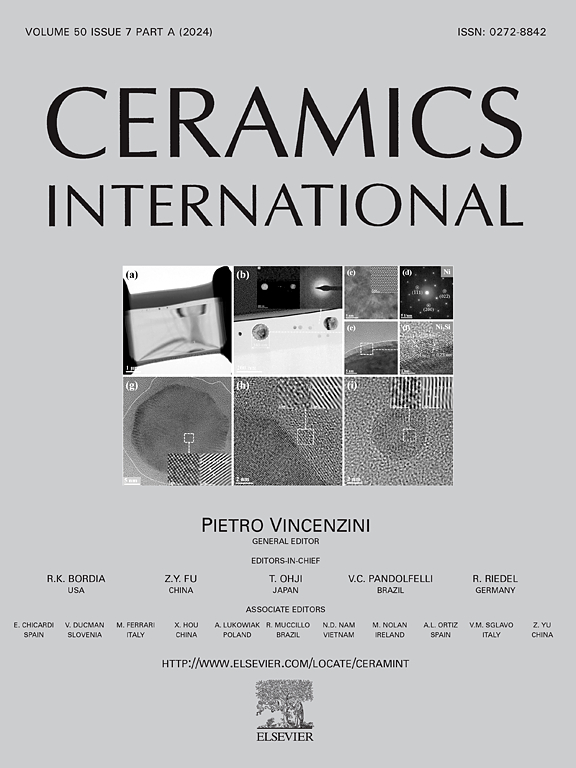MoSi2/云母/HSM改性CF/BPR复合材料在氧乙炔火焰长时间烧蚀过程中的烧蚀行为及机理
IF 5.1
2区 材料科学
Q1 MATERIALS SCIENCE, CERAMICS
引用次数: 0
摘要
烧蚀热防护材料因其适应性强而广泛应用于入、再入飞行器。然而,由于烧蚀材料基体的消耗,长期烧蚀一直是一个限制。本文研究了MoSi2/云母改性CF/BPR复合材料在长时间烧蚀下的微观结构演变和烧蚀性能。随着消融时间的延长,质量消融率降低,线性消融率升高。体积% hsm的复合材料具有良好的绝缘性能,烧蚀100 s后背面温度降低至240.9℃。导热系数的降低限制了轴向和水平方向的传热。这导致了中心表面的热量集中和严重的烧蚀。在传递区形成三维多孔和阶梯结构,随着烧蚀时间的延长,由于火焰侵蚀和液相的形成,这些特征逐渐消失。热在基体内部的扩散和集中建立了梯度温度场,确定了烧蚀行为和机理,为开发先进的烧蚀热防护材料提供了有价值的见解。本文章由计算机程序翻译,如有差异,请以英文原文为准。
Ablation behavior and mechanism of MoSi2/mica/HSM modified CF/BPR composites during prolonged ablation of oxyacetylene flame
Ablative thermal protection materials are widely used in entry and re-entry vehicles which benefit from their strong adaptability. However, long-term ablation has been a limitation due to the consumption of the matrix of the ablative materials. In this work, the microstructure evolution and ablation properties of the MoSi2/mica-modified CF/BPR composites with and without hollow silicate glass microspheres (HSMs) under protracted ablation have been investigated. The mass ablation rates decreased while the linear ablation rates increased when the ablation times were prolonged. The composites with 30 vol.% HSMs have good insulation properties, shown by a lower backside temperature of 240.9 °C after 100 s of ablation. The decrease in thermal conductivity limited heat transfer in both the axial and horizontal directions. This led to heat concentration and severe ablation at the central surface. The three-dimensional porous and the ladder structure formed in the transfer region, and the features gradually disappeared while extending the ablation times because of the flame erosion and formed liquid phases. The heat diffusion and concentration within the matrix established a gradient temperature field, which determined the ablation behavior and mechanism, providing valuable insights for the development of advanced ablative thermal protection materials.
求助全文
通过发布文献求助,成功后即可免费获取论文全文。
去求助
来源期刊

Ceramics International
工程技术-材料科学:硅酸盐
CiteScore
9.40
自引率
15.40%
发文量
4558
审稿时长
25 days
期刊介绍:
Ceramics International covers the science of advanced ceramic materials. The journal encourages contributions that demonstrate how an understanding of the basic chemical and physical phenomena may direct materials design and stimulate ideas for new or improved processing techniques, in order to obtain materials with desired structural features and properties.
Ceramics International covers oxide and non-oxide ceramics, functional glasses, glass ceramics, amorphous inorganic non-metallic materials (and their combinations with metal and organic materials), in the form of particulates, dense or porous bodies, thin/thick films and laminated, graded and composite structures. Process related topics such as ceramic-ceramic joints or joining ceramics with dissimilar materials, as well as surface finishing and conditioning are also covered. Besides traditional processing techniques, manufacturing routes of interest include innovative procedures benefiting from externally applied stresses, electromagnetic fields and energetic beams, as well as top-down and self-assembly nanotechnology approaches. In addition, the journal welcomes submissions on bio-inspired and bio-enabled materials designs, experimentally validated multi scale modelling and simulation for materials design, and the use of the most advanced chemical and physical characterization techniques of structure, properties and behaviour.
Technologically relevant low-dimensional systems are a particular focus of Ceramics International. These include 0, 1 and 2-D nanomaterials (also covering CNTs, graphene and related materials, and diamond-like carbons), their nanocomposites, as well as nano-hybrids and hierarchical multifunctional nanostructures that might integrate molecular, biological and electronic components.
 求助内容:
求助内容: 应助结果提醒方式:
应助结果提醒方式:


